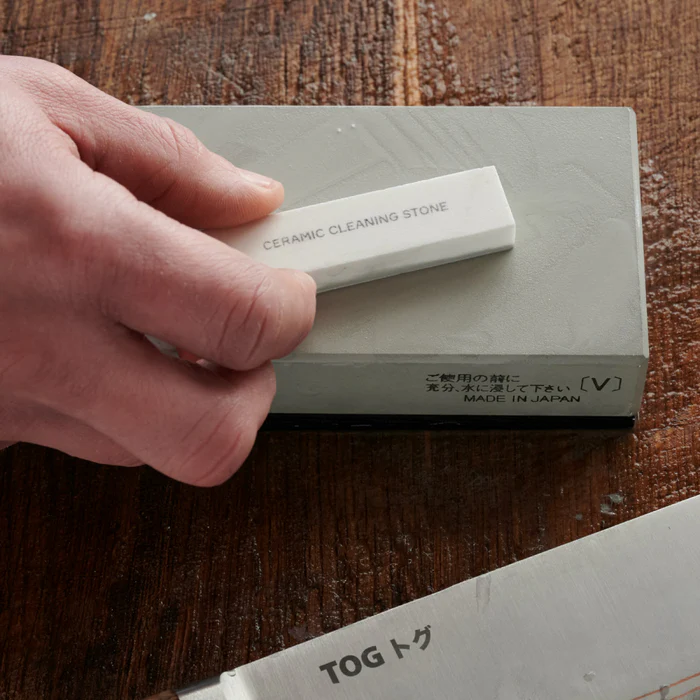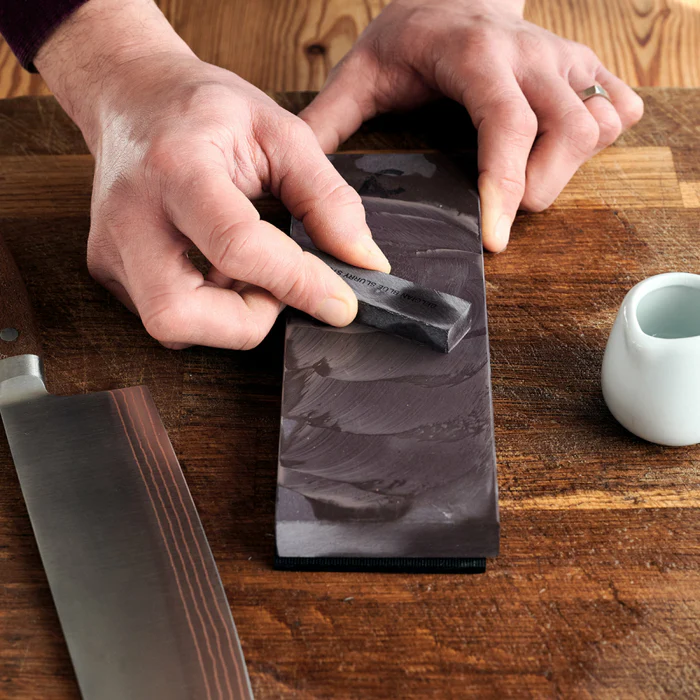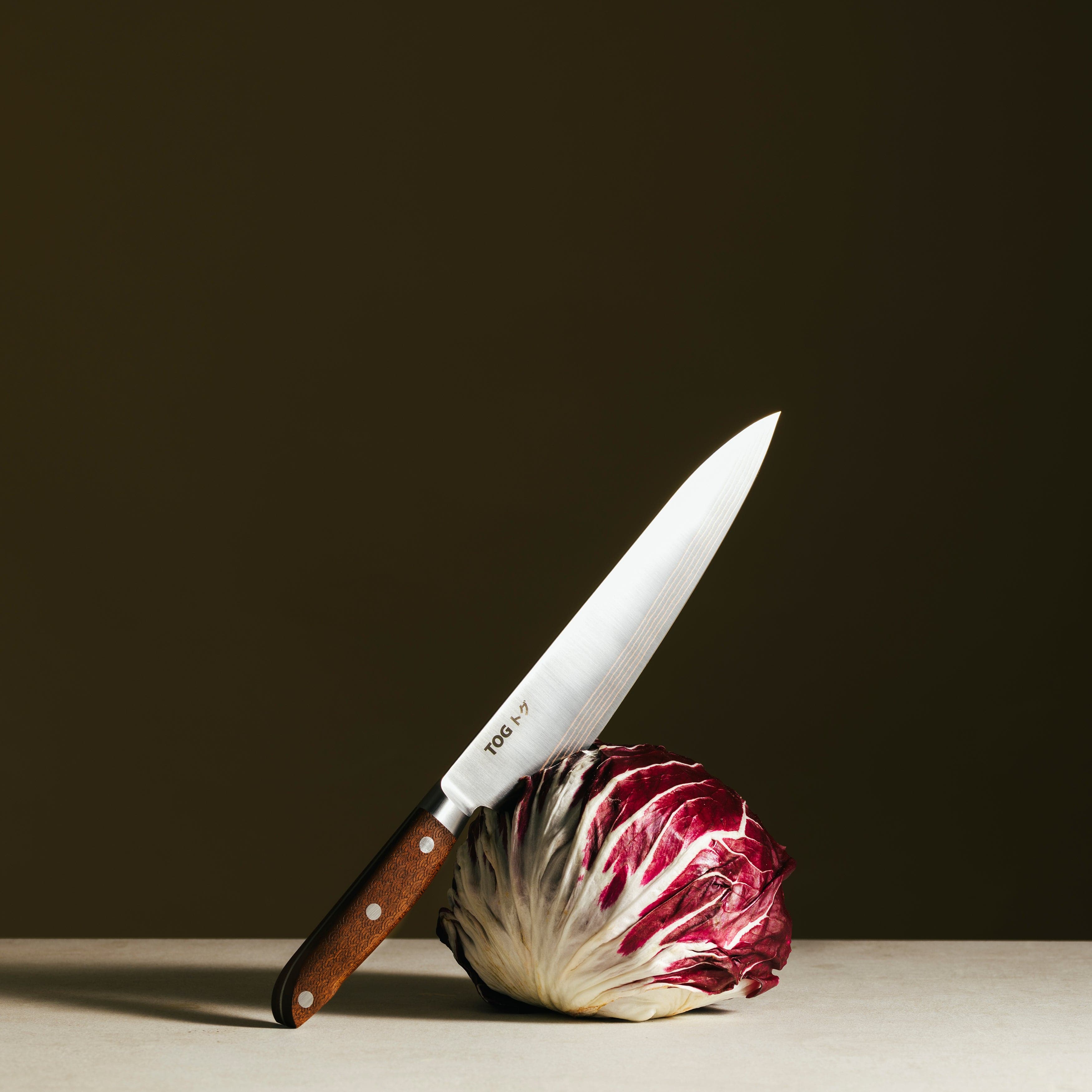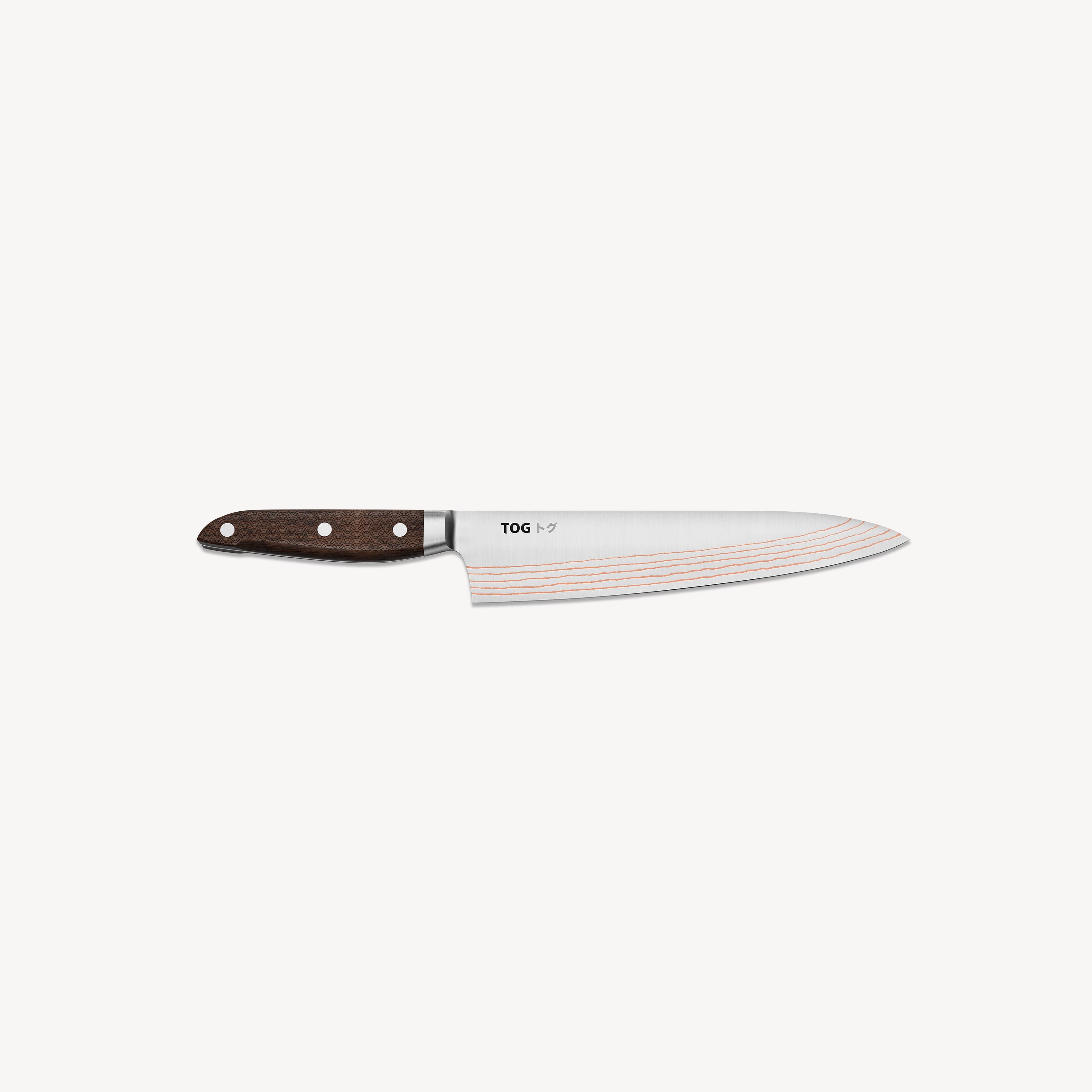KITCHEN KNIVES
knife storage
The best ways of storing your knives are on a magnetic knife block or rack. These methods display the knives well and also protect your blades. A knife roll is a great way of transporting knives. Whatever you choose, make sure the blades are protected and that the knives are dry.

BLADE DAMAGE
Microscopic portions of your blade get bent over or chipped during normal use. A ceramic honing rod will straighten (hone) your edge. Whetstones are needed to remove chips, or use our sharpening and repair service. Always cut on a wooden or plastic board, never a ceramic plate or glass. And please don’t try to cut frozen foods, shuck an oyster or open a tin of beans (!).

OXIDATION & CORROSION
The copper lines on your TOG blade may darken with use. Don’t worry, this is normal oxidation. Rubbing lemon and salt on the blade can restore the appearance. Don’t do this too often as it can erode the copper. Stainless steel is not 100% corrosion-free. Rust spots can appear, especially if your knives are put in a dishwasher, left in water, or not dried after washing. Remove spots carefully with a blade cleaner or coarse wire wool. Scourers will scratch your blades.

HANDLE OIL
The handles of our knives are made of Kebony maple. Kebony is impermeable so we finish them with two coats of Danish oil. This forms a hard coating rather than soaking in. If this eventually wears off, you can restore the appearance of your knife by applying more oil.

CLEANING KNIVES
Please wash and dry TOG knives by hand straight after use with a non-scratch washing up sponge or a cloth. This will keep your blade in top shape. Putting a TOG knife in a dishwasher is certainly not a way to honour it. In fact this will void your guarantee. Dishwashers stress the handles of knives, encourage corrosion and rattle them against other metal utensils, dulling the blades.

KNIFE SAFETY
Some people say blunt knives are more dangerous than sharp ones. This is because you have to apply more pressure and because they might slip sideways instead of cutting down. We say sharp ones are dangerous too. So please do take care when using our knives and keep them out of the reach of children. For many people TOG will be much sharper than the knives you’re used to.

STAY SHARP
TOG Knives have exceptional edge retention, but all knives eventually lose their edge with use. To keep your knives razor sharp, visit our Sharpening Guide or use our postal Sharpening and Repair Service.

CHOPPING BOARDS
WOODEN CHOPPING BOARDS
Wipe your TOG board with a damp cloth to clean it. To remove fat or oil, use warm water and a small amount of detergent. Regularly apply our board balm to avoid the loss of natural oils from the wood and help prevent cracking. This also maintains the board’s water resistance, extends its life and keeps it looking beautiful. Rub the balm over the whole surface with a rag or with your hands. Lemon and coarse salt can also be rubbed on the board to remove stubborn odours. Please don’t put your board in a dishwasher, leave it soaking in water, treat it with bleach, abrasives or alcohol or oil it with vegetable or olive oil.

PAPERBOARDS
Any initial marking of the surface will even out with longer term use, so don't worry. Paperboards are super-tough and can be scrubbed aggressively with a scourer if required. This can even out and renew the surface. Rinse afterwards. The easiest way to clean Paperboards is in the dishwasher. If the surface colour fades with long term use, this can be restored with a little TOG Board Balm applied with a rag.

SHARPENING PRODUCTS
JAPANESE WHETSTONE CARE
After using a TOG Japanese ceramic whetstone, wash the stone, clean up the surface with the little cleaning stone then wash again. If there is any dishing, rub the surface against a diamond plate (under a tap is good) or anohter whetstone until it’s totally flat. Dry your stone completely (48hrs) before returning it to its wooden box for storage.

BELGIAN BLUE WHETSTONE CARE
The Belgian Blue should be dried before returning it to its wooden box for storage. As soon as it looks dry, it is dry (about 5min). You can clean it before drying it, or keep the slurry and dry it with the slurry on it. The slurry stone can also be used for cleaning up the surface of the stone. The Belgian Blue can also be flattened with a diamond plate if it starts becoming dished.

HONING ROD CARE
Clean the rod firmly using a damp cloth. This will remove steel particles from the fine abrasive surface and keep it working well. If the rod has been in contact with oil, clean with washing-up liquid and then rinse and dry. Avoid dropping the rod on the floor – the product’s shock absorber system absorbs 70% of impacts but it’s still possible that it could break.

HIGONOKAMI
STIFFNESS ADJUSTMENT
The blade of a Higonokami is held into the handle with a rivet which also works as the pivot. As these knives are hand made, the tightness can vary. To make the blade tighter, place the rivet on something hard and heavy like an anvil and tap with a hammer. Start gently and increase power as required! If the knife is too tight, turn it upside down and tap the blade release handle (“Chikiri”) on a table.

OXIDATION
Any oxidation or corrosion on the blade of a Higonokami can be removed with a TOG Blade Cleaner.

HIGONOKAMI SHARPENING
Higonokami Knives can be sharpened at an angle of 20º to the whetstone, using the same method you would use to sharpen a kitchen knife. With a Higonokami, you can also use the ‘Scandi’ method. Click below for detailed information about sharpening Higonokami.

Featured collection
Bestseller















